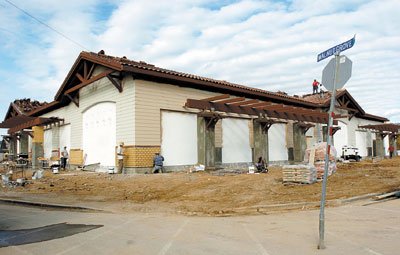Morgan Hill
– It just got a whole lot cheaper to build commercial projects
in Morgan Hill, thanks to a huge reduction in traffic and sewer
impact fees – charges levied on builders to offset the additional
stresses on roads, sewer lines and other infrastructure from the
additional people using the various sy
stems.
Morgan Hill – It just got a whole lot cheaper to build commercial projects in Morgan Hill, thanks to a huge reduction in traffic and sewer impact fees – charges levied on builders to offset the additional stresses on roads, sewer lines and other infrastructure from the additional people using the various systems.
To offset the lost revenue, the city’s Redevelopment Agency plans to invest $65 million in roads and sewer projects through 2020.
The reduced fees took effect Monday, saving developers 50 to 75 percent when they pull building permits for projects in the RDA area.
For example, someone building a 40,000-square-foot office building would now pay $82,000 in impact fees versus $305,000 before the reduction, resulting in a savings of 73 percent. On the same token, a developer of a 5,000 square-foot restaurant now saves 74 percent on impact fees, paying $47,000 versus $181,000.
Those savings put Morgan Hill on a better footing to compete with other growing cities in Silicon Valley for the most desirable businesses, city officials say.
“I think what it does is, it gives us more of a competitive advantage compared to other cities in Silicon Valley,” said Garrett Toy, who heads up the city’s Business Assistance and Housing Services Department. “Before the reduction, we had the highest fees in the county, next to Palo Alto.”
Now Morgan Hill’s closer to the other end of the spectrum, right above San Jose and Sunnyvale, neck and neck with Milpitas and Fremont. Mountain View, however, remains tough to beat – it has no traffic and sewer impact fees.
According to the city, the old fee schedule was labeled an “economic inhibitor” by local business leaders who lobbied for adjustments.
To make up for the lost revenue from the lowered fees the RDA plans a $65 million investment in infrastructure through 2020.
The city’s RDA was created in 1981 as a way to fund capital improvement projects. A map of the redevelopment area was drawn, and property taxes in that area that normally go to the county and other agencies are diverted back to the RDA. The Morgan Hill City Council acts as the RDA’s governing board. Last November, the board approved a $333 million RDA plan lasting through 2020.
The list of traffic improvement projects the RDA may fund includes the widening of Tennant Avenue at the U.S. 101 over-crossing; the extension of Butterfield Boulevard south to Watsonville Road; median and landscaping improvements on Monterey Road; the extension of Santa Teresa Boulevard from Main Street to Spring Street; and various other road improvements.
“The RDA is paying for the improvements traffic fees would otherwise pay for,” Toy said. “But with fees, you don’t know when you’re getting the money. The RDA has decided, let’s just go ahead and do these things.”
Similar to traffic impact fees, sewer fees are charged to new developers to pay for infrastructure improvements. The RDA plans to spend up to $20 to expand sewer capacity within the RDA project area through 2020, reducing the need to collect fees for such projects. Commercial and industrial projects in the RDA project area will no longer be assessed sewer impact fees. Residential projects will continue to be charged, except if they are located within the downtown region roughly defined as Del Monte Avenue, Main Avenue, Butterfield Boulevard and Bisceglia Avenue.














